Religion in Bangladesh
This article needs additional citations for verification. (January 2017) |



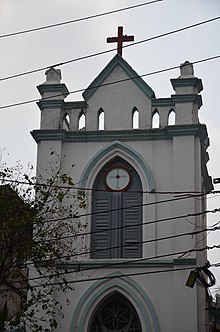
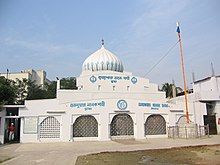
| Part of a series on the |
| Culture of Bangladesh |
|---|
 |
| History |
| Traditions |
| Religion |
| Sport |
|
The United Nations categorizes Bangladesh as a moderate democratic "Muslim country".[2][3] In the Constitution of Bangladesh, Islam is referred to twice in the introduction and Part I of the constitution. The document begins with the Islamic phrase (بِسْمِ اللهِ الرَّحْمٰنِ الرَّحِيْمِ) which in English is translated as “In the name of Allah, the Beneficent, the Merciful” and article (2A) declares that :"Islam is the state religion of the republic".[4] Prime Minister Sheikh Hasina has stated that Bangladesh will be governed in line with the spirit of the Constitution of Medina.[5][6] But at the same time, the Constitution of Bangladesh calls secularism one of the four fundamental principles of the original Constitution of Bangladesh.[7] Despite having Islam as the state religion, Bangladesh is mostly governed by secular laws, set up during the times when the country was ruled by the British Crown.[8] The constitution also states that "the State shall ensure equal status and equal right in the practice of the Hindu, Buddhist, Christian and other religions".[9] "Freedom of religion" is its basic structure guaranteed by Bangladeshi constitution in which it calls for equal rights to all its citizens irrespective of their religious differences and it also bans discrimination on the grounds of religion in various platforms. Bangladesh is one of the few secular Muslim-majority nations and "proselytizing" i.e. conversions from one religion to another are generally accepted and is legalized by law under article 41 of the constitution, subject to law, public order and morality.[10]
A survey in late 2003 confirmed that religion is the first choice by a citizen for self-identification. The Constitution denominates Islam, Hinduism, Christianity, and Buddhism.[9]
| Religion | Population |
|---|---|
| Muslims ( |
135,394,218 |
| Hindus ( |
12,730,651 |
| Buddhists ( |
898,635 |
| Christians ( |
599,090 |
| Others | 149,770 |
| Total | 149,772,364 |
Islam[]
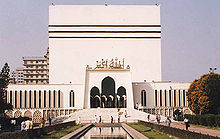
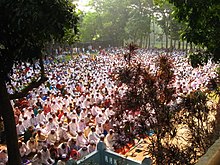
The Muslim population in Bangladesh was over 135.4 million in 2011, which makes up 90.4 per cent percent of the population in the country.[12] Estimation shows that over 1 million Rohingya Muslim refugees live in Bangladesh who have came here during the period of (2016–17) crisis.[13] On 28 September 2018, at the 73rd United Nations General Assembly, Bangladeshi Prime Minister Sheikh Hasina said there are 1.1-1.3 million Rohingya refugees now in Bangladesh.[14][15] The Constitution of Bangladesh declares Islam as the state religion. Bangladesh is the fourth-largest Muslim-populated country. Muslims are the predominant community of the country and they form the majority of the population in all eight divisions of Bangladesh. Overwhelming majority of Muslims in Bangladesh are Bengali Muslims at 88 per cent, but a small segment about 2 per cent of them are Bihari Muslims. Most Muslims in Bangladesh are Sunnis, but there is a small Shia community. Most of those who are Shia reside in urban areas.[citation needed] Although these Shias are few in number,[16] Shia observance commemorating the martyrdom of Muhammad's grandson, Husain ibn Ali, is widely observed by the nation's Sunnis.[17] Muslims celebrate Eid ul-Fitr, Eid ul-Adha, Muharram, Milad un Nabi, Shab-e-Barat and Chand Raat all across the country with much fanfare and grandeur. The annual Bishwa Ijtema is the largest and most notable congregation of Muslims in Bangladesh.
The Muslim community in the Bengal region i.e., Bangladesh and West Bengal, developed independently of the dominant Islamic trends in India. Features of Bangladeshi Hinduism, which differed in some respects from Hinduism in other parts of South Asia, influenced both the practices and the social structure of the Bangladeshi Muslim community. In spite of the general personal commitment to Islam by the Muslims of Bangladesh, observance of Islamic rituals and tenets varies according to social position, locale, and personal considerations. In rural regions, some beliefs and practices tend to incorporate elements that differ from and often conflict with orthodox Islam. According to Aziz Ahmad, Arabic Islamic scholars have considered the form of Islam followed in Bengal i.e. (Bangladesh, West Bengal) to have some elements of Crypto-Hinduism in it.
Hinduism[]


Hinduism is the second largest religious affiliation in Bangladesh, with around 12.73 million people identifying themselves as Hindus out of 149.7 million people and making up about 8.5 per cent of the total population as second largest minority according to 2011 census.[1][18] In terms of population, Bangladesh is the third largest Hindu populated country of the world, just after India and Nepal.[19]
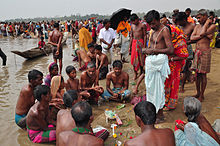
Bangladeshi Hindus are predominantly Bengali Hindus, but a distinct Hindu population also exists among the indigenous tribes like Garo, Khasi, Jaintia, Santhal, Bishnupriya Manipuri, Tripuri, Munda, Oraon, Dhanuk etc. Hindus are evenly distributed throughout all regions of Bangladesh, with significant concentrations in northern, southwestern and northeastern parts of the country. In nature, Bangladeshi Hinduism closely resembles the rituals and customs of Hinduism practised in the neighbouring Indian state of West Bengal, with which Bangladesh (at one time known as East Bengal) was united until the partition of India in 1947. Hindu festivals of Durga Puja, Rath Yatra and Janmashtami witness jubilant celebrations across various cities, towns and villages of Bangladesh.
Buddhism[]


About 1,000,000 people in Bangladesh adhere to the Theravada school of Buddhism. Buddhists form about 0.6 per cent of the population of Bangladesh.
In antiquity, the region of present-day Bangladesh was a center of Buddhism in Asia. Buddhist civilisation, including philosophies and architecture, traveled to Tibet, Southeast Asia and Indonesia from Bengal. The Buddhist architecture of Cambodia, Indonesia and Thailand, including the Angkor Wat Temple and the Borobudur vihara, are believed to have been inspired by the ancient monasteries of Bangladesh such as the Somapura Mahavihara. Strange though it may now seem in such an overwhelmingly Muslim country, Buddhism has been no small player in the nation's history and culture.
Most of the followers of Buddhism in Bangladesh live in the Chittagong division. Here, Buddhism is practised by the Bengali-speaking Baruas, who are almost exclusively Buddhist and are concentrated heavily in the Chittagong area as well as few of the Barua Buddhists live in other parts of Bangladesh, such as Comilla, Mymensingh, Rangpur, Sylhet districts. Most of the followers of Buddhism in Bangladesh live in southeastern region, especially in the Chittagong Hill Tracts, Chittagong and Comilla district. Most of the Buddhists of Chittagong Hill Tracts belong to the Chakma, Marma, Mru, Khumi, Bawm, Chak, Kuki, Murang, Tanchangya and Khiang tribes, who since time immemorial have practised Buddhism. Other tribal communities who practise animism, have come under some Buddhist influence. The beliefs and rituals of the Buddhist communities in this region are amalgamations of Buddhism and ancient animistic faiths. Buddha Purnima is the most widely observed festival among both Bengali Buddhists and Buddhist tribes.
Christianity[]

Christianity arrived in what is now Bangladesh during the late sixteenth to early seventeenth centuries AD, through the Portuguese traders and missionaries. Christians account for approximately 0.4 per cent of the total population and they are mostly an urban community. Roman Catholicism is predominant among the Bengali Christians, while the remaining are mostly Baptist and others. Few followers of Christianity are also present among certain indigenous tribal communities such as Garo, Santal, Orao, Chakma, khasi, Lushei, Bawm, etc.
The Church of Jesus Christ of Latter-day Saints (LDS) also exists in Bangladesh.
Other religions[]
Bangladesh has a small community of the Baháʼí Faith. Baháʼís have spiritual centres in Dhaka, Chittagong, Khulna, Rajshahi, Sylhet, Barisal, Rangpur, Mymensingh, Jessore, Rangamati and other places.
Bangladesh also has a tiny Brahmo Samaj community.
The Jehovah's Witnesses also exist in Bangladesh.
Sikhism[]

There are approximately 23,000 people adhering to the religion of Sikhism.[20] The presence of this religion goes back to the visitation of Guru Nanak in 1506–07 with some of his followers to spread Sikhism in the region of the present-day Bangladesh. When some Bengali people accepted this faith, a Sikh community was born.[21] This community became bigger when almost 10,000 Sikhs came from India during the Bangladesh Liberation War. This community has made great progress in the country. Today there are almost 10 gurdwaras in Bangladesh.[22] Among them only 7 are well-known, especially the Gurdwara Nanak Shahi beside the University of Dhaka in Dhaka, which was built in 1830, the oldest gurdwara in Bangladesh.
Secularism[]
Demographic landscape of Bangladesh before partition[]
East Bengal (present-day-Bangladesh) had a population of 39.12 million by the year (1947), of which 26.72 million people were followers of Islamic religion representing about (68.3%) of the region's population, while 11.73 million belongs to the Hindu faith constituting (30%) of the region.[24] Smaller number of 6.65 lakhs people follows Buddhism, Animism and Christianity together presenting around (1.7%) of the region.
Demographic landscape of Bangladesh before Independence from Pakistan (1974)[]
After 1974, East Pakistan became sovereign nation of People republic of Bangladesh. During that time the population of Bangladesh was found to be 68.7 million, of which majority of 58.7 million people professed to Islamic Faith comprising 85.4% of the country's population, Hindus are second largest community with a population of 9.28 million comprising 13.5% of the country's population, while 1.1% practices other religions like Buddhism and Christianity.[25]
Immigration & refugee crisis[]
Before Partition of Bengal, it was found that, the Muslim population of West Bengal stood at 30% and the Hindu population of East Bengal stood at 28% respectively. Soon after partition, Hindu population in East Bengal have reduced from 28% in 1941 to 22% in 1951, while Muslim population in West Bengal have reduced from 30% in 1941 to 19.85% in 1951. As per as study of recent demographic scenario of Bengal region, it was found that West Bengal Muslim population have increased from merely 19.85% in 1951 to 27% in 2011, while Bangladesh Hindu population have reduced from 22% in 1951 to merely 8.5% in 2011.[26][27]
During 1971 Bangladesh liberation war
It is estimated that during the time of Bangladesh liberation war, nearly three million Bengalis were killed by Pakistani army, majority of whom (60%-80%) being Hindus.[28][29] An official estimate also suggests that 200,000-400,000 Bengali women were raped by the Pakistani military and the supporting Bihari and Bengali Razakar and al-Badr militias.[30] An estimated population of around 10 million people most being 80% Hindus fled from East Pakistan to neighbouring India as refugees following the torture of Pakistani army, and after independence nearly an estimated population of 1.5-2 million Hindus stayed back in India and never went back.[31]
Aspects and practices of secularism[]
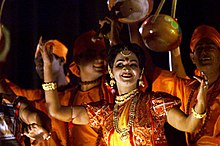
Bangladesh declared itself a secular state with its birth in 1971. Secularism was chosen as one of the four pillars that were to guide official policy of the nation. To certain extent Bangladeshi people were “secular”. Secularism in Bangladesh means pluralism of religious faiths as opposed to more expansive definitions of the term.[32] On October 12, 1972, while participating in a discussion in parliament on the draft of the constitution, Banagabandhu literally Sheikh Mujibur Rahman, the 1st Prime Minister of Bangladesh havw said: “We Bangladeshis believe in secularism. Secularism does not mean the absence of religion. Muslims, Hindus, Christians, Buddhists everyone will perform their own religion. No one can interfere with others’ religious beliefs. The people of Bangladesh do not want interference in religion.” “He further said that Religion cannot be used for political reasons. Religion will not be allowed to be used in Bangladesh for political purposes. He believed that if anyone does it, the people of Bangladesh will retaliate against them,”.[33] But soon after his death, the original constitution was changed in 1978 with installment of the phrase “absolute trust and faith in the Almighty Allah” as 5th amendment of the constitution by Ziaur Rahman government in order to replace secularism as a state principle. The military dictator who followed Rehman, Hussain Muhammad Ershad, went one step further and declared Islam as the official religion in 1988. Bangabandhu's party, the Bangladesh Awami League, once again came to the power in January 2009 with the promise to restore the 1972 constitution. They partially did so through the 15th Amendment to the constitution in 2013 but they kept Islam as the state religion.[32] In 2010, Bangladesh Supreme Court declared the 5th amendment illegal and restored secularism as one of the basic tenets of the Constitution[34] though Islam remained the state religion in the constitution.[35]
Main aspects of secular principles
Article 8 of part - (II) described secularism as the fundamental principles of state policy.[36] The main principles of Secularism in the Bangladeshi constitution were described under article 12 of Part- (II)[37] -
12. The principle of secularism shall be realised by the elimination of -
(a) Communalism in all its forms;
(b) The granting by the State of political status in favour of any religion;
(c) The abuse of religion for political purposes;
(d) Any discrimination against, or persecution of, persons practicing a particular religion.
Controversy
Islam is the state religion of Bangladesh by article 2A but this article came into direct conflict with the article 12 of part- (II) of 2nd stanza which states that "The state should not grant political status in favour of any religion" as secularism has been defined as one of the four fundamental principles of Bangladesh.[38][39][40] Article (2A) of the constitution also state's that "the state shall ensure equal status and equal right in the practice of the Hindu, Buddhist, Christian and other religions" while giving a special status to Islam which have led to a huge controversy regarding the country's foundation.[41][38] The Supreme Court of Bangladesh on 28 March 2016 upheld the status of Islam as the State religion.[42] The ruling was given by the High Court Division of the court while dismissing a petition which was almost about 28 years ago, filed by Samendra Nath Goswami challenging Islam as the religion of republic which directly contradicts with secular foundation of the nation.[43][44] Petition was also held earlier by Professor Anisuzzaman, one of the leaders of the petitioning organisation who said that Bangladesh was founded as a secular state, and having a state religion contradicts the basic structure of the constitution,”. [45][46] On 14th November, 2016 a senior ruling Awami League leader have said that Bangladesh will drop Islam as the country's state religion "when the time comes" and Islam has been kept as the state religion for strategic reasons," said the party's Presidium Member and former minister Abdur Razzaq.[47] The Bangladesh Army have close ideological association with centre-right and conservative political parties led by the Bangladesh Nationalist Party, and the army have also stated that the term Bangladeshi nationalism refers to the country as an Islamic nation given that 90% of the population of their nation is Muslim.[48] Every year, on 9th June, Bangladesh's Hindu, Buddhist and Christian religious unity leaders marked the day as "Black Day" together as because on this day of 1988 year, the country have been declared Islamic by General Hussain Muhammad Ershad. The Bangladesh Hindu Buddhist Christian Unity Council have also renewed its call several times for the 8th amendment Islam as state religion of republic to be scrapped from the constitution.[49] Recently on 4 July 2021, there was a huge debate going on parliament that keeping secularism in the country's constitution is against Islam and Quran. Harunur Rashid, a Bangladeshi lawmaker of BNP party member told to Prime Minister Sheikh Hasina in the parliament "that there is no mention of secularism in the Quran and it conflicts Islam". Then Bangladesh Prime Minister Sheikh Hasina have replied him back by stating "secularism in the constitution of Bangladesh never conflicts Islam as in the Quran there is a mentioned of the word - ('La'kum Dinukum Waliyadin') which means everybody has the right to follow their own belief and religion and s/he will follow his religion. The BNP lawmaker have also said that keeping secularism in the constitution is conflicting for the Muslim majority country leading to once more time a heated controversy regarding the country's foundation.[50][51]
Law, religion, and religious freedom[]
Although Bangladesh initially opted for a secular nationalist ideology as embodied in its Constitution, the principle of secularism was subsequently replaced by a commitment to the Islamic way of life through a series of constitutional amendments and government proclamations between 1977 and 1988. During the eighties, the state was designated exclusively Islamic. However, in 2010, the secularism of the 1972 Constitution[52] was reaffirmed.[53] The Government generally respects this provision in practice; however, some members of the Hindu, Christian, Buddhist, and Ahmadiyya communities experience discrimination. The Government (2001-2006), led by an alliance of four parties (Bangladesh Nationalist Party, Bangladesh Jamaat-e-Islami, Islami Oikya Jote and Bangladesh Jatiyo Party) banned the Ahmadiyya literature by an executive order.
Family laws concerning marriage, divorce, and adoption differ depending on the religion of the person involved. There are no legal restrictions on marriage between members of different faiths.
In 2010, secularism was restored, but Islam remains the nominal state religion per Article 12.[9]
Persecution of minorities[]
There have been several instances of violence against the religious minorities in Bangladesh. Hindus, Buddhists and Christians have come under widespread attacks by Islamist extremists during communal riots, elections and post-poll violence.
Most of these attacks target Hindus, the largest minority of the country, who are particularly vulnerable in a period of rising violence and extremism, whether motivated by religious, political or criminal factors, or some combination. Bangladesh has been rocked by several anti-Hindu riots in 1992, 2001, 2013 and 2014. These violent acts included attacking and killing Hindus, looting and burning of Hindu-owned properties and businesses, abduction and rape of women, desecrating and destroying Hindu temples by the extremist Muslim mobs. There is also alleged discrimination against Hindus by the administration in the form of Vested Property Act by which over 40 per cent of Hindu-owned lands and houses have been confiscated, intimidation during elections and revoking their names from electoral rolls. Since the rising of Islamist political parties during 1990s, large number of Hindu families have migrated from Bangladesh to India due to a sense of insecurity and economic necessity. These factors combined with lower birth rates of minorities have resulted in a dwindling Hindu population in the country.
The Bihari ethnic minority in Bangladesh has been subject to persecution during and after 1971 Liberation War. Due to their pro-Pakistan stance, many Biharis were forcefully repatriated to Pakistan and those who stayed back were not granted citizenship and voting rights by Bangladesh government.
Atheism[]
Atheism is not common in Bangladesh.[54] A survey, commissioned by WIN-Gallup International, conducted from 5 November 2014, to 25 November 2014, found that fewer than one per cent of Bangladeshi's said they were "convinced Atheists".[55][56]
There have been multiple attacks and murders of atheist bloggers, academics and authors by religious militants since 2013, with the government accused of being unable or unwilling to provide protection and in some cases even persecuting atheists and imprisoning them.
Further reading[]
- Benkin, Richard L. (2014). A quiet case of ethnic cleansing: The murder of Bangladesh's Hindus. New Delhi: Akshaya Prakashan.
- Dastidar, S. G. (2008). Empire's last casualty: Indian subcontinent's vanishing Hindu and other minorities. Kolkata: Firma KLM.
- Kamra, A. J. (2000). The prolonged partition and its pogroms: Testimonies on violence against Hindus in East Bengal 1946–64.
- Taslima Nasrin (2014). Lajja. Gurgaon, Haryana, India : Penguin Books India Pvt. Ltd, 2014.
- Rosser, Yvette Claire. (2004) Indoctrinating Minds: Politics of Education in Bangladesh, New Delhi: Rupa & Co. ISBN 8129104318.
- Mukherji, S. (2000). Subjects, citizens, and refugees: Tragedy in the Chittagong Hill Tracts, 1947–1998. New Delhi: Indian Centre for the Study of Forced Migration.
- Sarkar, Bidyut (1993). Bangladesh 1992: This is our home: Sample Document of the Plight of our Hindu, Buddhist, Christian and Tribal Minorities in our Islamized Homeland: Pogroms 1987–1992. Bangladesh Minority Hindu, Buddhist, Christian, (and Tribal) Unity Council of North America.
See also[]
References[]
- ^ Jump up to: a b c Bangladesh Bureau of Statistics (2011). "Population & Housing Census" (PDF). Bangladesh Government. p. xiii. Archived from the original (PDF) on 3 September 2017. Retrieved 17 April 2015.
Population By Religion (%) Muslim 90.39 Hindu 8.54 Buddhist 0.60 Christian 0.37 Others 0.14
- ^ "A moderate Muslim country!". 6 April 2010.
- ^ https://www.berfrois.com/2013/05/bangladesh-secular-bengalis-or-muslim-bangladeshis/
- ^ "The Constitution of the People's Republic of Bangladesh | 2A. The state religion". bdlaws.minlaw.gov.bd.
- ^ "Country to be run as per Madinah Charter: PM". The Daily Star. UNB. 22 March 2014. Retrieved 11 July 2017.
- ^ "Bangladesh's Ambiguity on Religion Has Been Expensive for the Country". The Diplomat.
- ^ "Secularism in Bangladesh: The troubled biography of a constitutional pillar". The Daily Star. 16 December 2020.
- ^ "People & Culture in Bangladesh". Lonely Planet.
- ^ Jump up to: a b c "The state religion". bdlaws.minlaw.gov.bd. Retrieved 17 July 2015.
- ^ "The Constitution of the People's Republic of Bangladesh | 41. Freedom of religion". bdlaws.minlaw.gov.bd.
- ^ Data Archived 4 September 2011 at the Wayback Machine. Census – Bangladesh Bureau of Statistics
- ^ http://203.112.218.65:8008/WebTestApplication/userfiles/Image/National%20Reports/Union%20Statistics.pdf
- ^ "Bangladesh is now home to almost 1 million Rohingya refugees". Washington Post. ISSN 0190-8286. Retrieved 21 June 2021.
- ^ "Bangladesh point finger at Myanmar for Rohingya 'genocide'". Associated Press. 27 September 2018.
- ^ "WHO appeals for international community support; warns of grave health risks to Rohingya refugees in rainy season - Bangladesh". ReliefWeb.
- ^ "One killed and scores wounded in attack at Shia site in Bangladesh capital". The Guardian. Agence France-Presse. 24 October 2015. ISSN 0261-3077. Retrieved 27 March 2016.
- ^ "Islam in Bangladesh". OurBangla. Archived from the original on 10 February 2012.[self-published source]
- ^ "Door out of Dhaka". The Times of India.
- ^ "[Analysis] Are there any takeaways for Muslims from the Narendra Modi government?". DNA. 27 May 2014. Retrieved 31 May 2014.
- ^ "Countries With The Largest Sikh Populations". WorldAtlas. Retrieved 21 June 2021.
- ^ "Bangladesh-Gurudwaras of World".
- ^ Mohanta, Sambaru Chandra (2012). "Gurdwara Nanak Shahi". In Islam, Sirajul; Jamal, Ahmed A. (eds.). Banglapedia:National Encyclopedia of Bangladesh (Second ed.). Asiatic Society of Bangladesh.
- ^ Jump up to: a b Islam, M Ataharul; Karmaker, Shamal Chandra (2012). "Population". In Islam, Sirajul; Jamal, Ahmed A. (eds.). Banglapedia: National Encyclopedia of Bangladesh (Second ed.). Asiatic Society of Bangladesh.
- ^ "Truth, half-truth and statistics". Times of India Blog. 20 July 2017. Retrieved 21 June 2021.
- ^ "Bangladesh - Population 1974".
- ^ https://www.newdelhitimes.com/demographic-changes-is-bengal-sitting-on-a-volcano123/
- ^ Nahid Kamal. "The Population Trajectories of Bangladesh and West Bengal During the Twentieth Century: A Comparative Study" (PDF).
- ^ "Bangladesh: The Forgotten Genocide – UAB Institute for Human Rights Blog".
- ^ "Not Bengalis, Hindus were Pakistani targets in 1971 Bangladesh War, claims new book". The Indian Express. 16 October 2013.
- ^ "Birth of Bangladesh: When raped women and war babies paid the price of a new nation". 19 December 2016.
- ^ "When Indira Gandhi said: Refugees of all religions must go back – Watch video".
- ^ Jump up to: a b "Bangladesh's Ambiguity on Religion Has Been Expensive for the Country".
- ^ https://www.dhakatribune.com/bangladesh/nation/2021/08/09/bangabandhu-s-vision-of-secular-bangladesh-abandoned-after-his-demise
- ^ "Bangladesh's court restores 'secularism' in Constitution". 29 July 2010.
- ^ "Secularism is back in Bangladesh, rules High Court". 5 October 2010.
- ^ "The Constitution of the People's Republic of Bangladesh | 8. Fundamental principles". bdlaws.minlaw.gov.bd. Retrieved 21 June 2021.
- ^ "The Constitution of the People's Republic of Bangladesh | 12. Secularism and freedom of religion". bdlaws.minlaw.gov.bd. Retrieved 21 June 2021.
- ^ Jump up to: a b "404".
- ^ "404".
- ^ "Bangladesh cannot have a State religion and be secular at the same time". 7 March 2016.
- ^ "State religion and secularism: Bangladesh's double standards". UCA News.
- ^ Sattar, Maher; Barry, Ellen (28 March 2016). "In 2 Minutes, Bangladesh Rejects 28-Year-Old Challenge to Islam's Role". The New York Times.
- ^ "State religion and secularism: Bangladesh's double standards - UCA News".
- ^ "Bangladesh cannot have a State religion and be secular at the same time". Hindustan Times. 7 March 2016.
- ^ "Bangladesh Supreme Court upheld Islam as State religion". 29 March 2016.
- ^ "Bangladesh court upholds Islam as religion of the state". Al Jazeera.
- ^ "Bangladesh Will Drop Islam as State Religion 'When Time Comes,' Says Ex Minister: Report". NDTV.
- ^ "CIA – The World Factbook". Cia.gov. Retrieved 23 January 2013.
- ^ "Hindus, Buddhists and Christians say no to Islam as state religion".
- ^ "'Secularism in the constitution of Bangladesh never conflicts Islam'".
- ^ https://citytoday.news/secularism-in-constitution-of-bangladesh-never-conflicts-islam-sheikh-hasina/
- ^ "Secularism and freedom of religion". bdlaws.minlaw.gov.bd. Retrieved 27 March 2016.
- ^ "Verdict paves way for secular democracy". The Daily Star. 30 July 2010. Retrieved 22 August 2010.
- ^ Khan, Razib (13 May 2015). "Atheists in Bangladesh May Not be Totally Doomed".
- ^ "End of Year Survey 2014: Regional & Country Results". p. 10. Archived from the original on 15 November 2015.
- ^ "Losing Our Religion? Two Thirds of People Still Claim to Be Religious". Gallup International. 8 June 2015.
| Wikiquote has quotations related to: Religion in Bangladesh |
- Religion in Bangladesh
- Religious demographics